Kenya Economic Update (KEU)
-
Fostering Trade for Robust Growth and Dynamic Job Creation29TH KENYA ECONOMIC UPDATE, JUNE 2024
-
A Balancing Act - Opportunities for Making Growth More Inclusive During Challenging Times28TH KENYA ECONOMIC UPDATE, DECEMBER 2023
Economic growth weakened in advanced economies, contributing to a decline in global growth in 2023. Tight monetary policy weighed substantially on economic activity of advanced economies, with considerable slowdowns predicted for the Euro Area in 2023. The rapid rise in interest rates in the U.S. has led to substantial tightening of financial conditions for the emerging market and developing economies (EMDEs), with the more vulnerable EMDEs facing potential financial disruptions. Lower growth was also recorded for sub-Saharan African countries, decelerating from 2022 to 2023. This has been attributed to, among others, tight domestic macroeconomic policies in response to elevated inflation and fiscal challenges, exacerbated by global uncertainty and tight global financial conditions. The country will therefore need to both continue with a tight macroeconomic stance in the short run while charting a path to inclusive, productivity-led economic growth in the long run. This Economic Update proposes a concerted three-pronged strategy that: (i) increases productivity of the private sector across services sectors, agriculture and industry to ensure sustained high rates of economic growth, (ii) connects the poor and vulnerable to growth through access to skills, productive jobs, and capital, and (iii) strengthens households’ resilience to shocks, particularly extreme weather shocks given their growing incidence and the importance of agriculture as an important sector from an inclusion perspective. A more effective use of fiscal policies across these three pillars to support inclusion is important. These strategic directions could pave the way for inclusive growth.
-
Securing Growth: Opportunities for Kenya in a Decarbonizing World27TH KENYA ECONOMIC UPDATE, MAY 2023
Kenya’s economic performance softened in 2022, steering towards country’s long-term growth rate. Real GDP expanded by 4.8 percent in 2022, a deceleration compared with the strong rebound from the Covid-19 crisis at 7.5 percent annual growth in 2021 but broadly aligned with growth rates of Kenya’s potential GDP as well as of the pre-pandemic decade. The adverse weather shock of the last two years has been a major drag on economic growth, with growth in real GDP excluding agriculture standing at 6.3 percent in 2022. Besides, the impacts of tightening of domestic macroeconomic policies and challenging global financial conditions significantly hurt domestic economic activity, especially in the latter half of the year.
-
Continued Rebound, but Storms Cloud the Horizon - Policies to Accelerate the Productive Economy for Inclusive Growth26TH KENYA ECONOMIC UPDATE, DECEMBER 2022
Kenya’s rebound from the pandemic continued in 2022. Driven by broad-based increases in services and industry, real Gross Domestic Product (GDP) increased by 6.0 percent Year-on-Year (y/y) in the first half (H1) of 2022. However, the agriculture sector contracted by 1.5 percent during thesame period, and with the sector contributing almost one fifth of GDP, its poor performance pulled back GDP growth by 0.3 percentage points. Notwithstanding the strong y/y creases, GDP has seen a marked sequential slowdown since the 2021 third quarter (Q3) as base effect dissipatedand business confidence weakened because of the global commodity market shock, a long regional drought and domestic political uncertainty in the run up to the August 2022 general elections. Business confidence however picked up in the wake of a smooth transition of power following a largely peaceful presidential election. Kenya’s growth prospects remain bright; however, emerging shocks are challenging the broad-based rebound. Thebaseline assumes robust growth of credit to private sector, contained COVID-19 infections, and high commodity prices favorable for Kenyan exports to boost Kenya’s growth in the medium term. However, the ongoing shocks, including the long drought in arid and semi-arid areas, rising inflation,and tighter global financial conditions, create challenges for Kenya to sustain its recovery.
-
Aiming High: Securing Education to Sustain the Recovery25TH KENYA ECONOMIC UPDATE, JUNE 2022
Descriptions: Kenya managed to contain the health and economic impacts of multiple Coronavirus (COVID-19) waves in 2021, helped by targeted containment measures and progress on vaccination, but is now facing a potentially large economic shock from the war in Ukraine. One sector is critical to achieving Kenya’s development goals, accounts for a large share of government spending, and was hit hard by the COVID-19 pandemic: education. Accordingly, the special topic of this Kenya Economic Update (KEU) is the performance and financing of the education sector, drawing on a forthcoming World Bank Public Expenditure Review (PER) on education. It examines the impressive improvements which Kenya has achieved in education outcomes, the remaining challenges in the sector including charting a successful recovery from the pandemic, and how the allocation of resources can contribute to resolving these.
-
From Recovery to Better Jobs24TH KENYA ECONOMIC UPDATE, DECEMBER 2021
The Kenya Economic Update (KEU) is a World Bank report series produced twice a year that assesses recent economic and social developments and prospects in Kenya, and places these in a longer-term and global context. Through special topics, the KEU also examines selected policy issues and medium-term development challenges in Kenya. It is intended for a wide audience, including policymakers, business leaders, financial market participants, and the community of analysts and professionals engaged in Kenya’s changing economy.
-
Rising Above the Waves23RD KENYA ECONOMIC UPDATE, JUNE 2021
The pandemic has dealt a major blow to the economy, but the government’s quick policy responses have helped to cushion the impact, and a partial recovery is underway. In response to the improving conditions, many of the tax and regulatory relief measures extended at the onset of the crisis have been discontinued. The economy is expected to continue to recover and gradually return to growth of above 5 percent. The near-term economic outlook for Kenya, as elsewhere, remains unusually uncertain and contingent on the course of the pandemic.
-
Navigating the Pandemic22ND KENYA ECONOMIC UPDATE, NOVEMBER 2020
Kenya’s economy has been hit hard by COVID-19, severely affecting incomes and jobs. The economy has been exposed through the dampening effects on domestic activity of the containment measures and behavioral responses, and through trade and travel disruption (affecting key foreign currency earners such as tourism and cut flowers). Real Gross Domestic Product (GDP) contracted by 0.4 percent in H1 2020 year-on-year(y/y), compared to growth of 5.4 percent in H1 of 2019. This reflects a worse-than-anticipated Q2 GDP outturn, mainly due to a sharp reduction of services sector output, especially education. As a result, the economy is projected to contract by 1.0 percent in 2020 in the baseline scenario, and by 1.5 percent in a more adverse scenario. This revision essentially adopts the adverse scenario outlined in the April 2020 update, reflecting the more severe impact of the pandemic to date than had been initially anticipated, including on the measured output of the education sector following the closure of institutions in March. The special focus topic finds that the pandemic increased poverty by 4 percentage points (or an additional 2 million poor) through serious impacts on livelihoods, by sharp decreases in incomes and employment. The unemployment rate increased sharply, approximately doubling to 10.4 percent in the second quarter as measured by the KNBS Quarterly Labor Force Survey. Many wage workers who are still employed face reduced working hours, with average hours decreasing from 50 to 38 hours per week. Almost 1 in 3 household run businesses are not currently operating, and between February and June average revenue from household run businesses decreased by almost 50 percent. This has exacerbated food insecurity, and elevated pain and human suffering. In response to the crisis, the government has deployed both fiscal and monetary policies to support the healthcare system, protect the most vulnerable households, and support firms to help preserve jobs, incomes and the economy’s productive potential. Tax revenue dropped below target, due to the marked slowdown in economic activity, as well as tax relief as part of the government’s fiscal response package. At the same time, expenditures were raised to strengthen the capacity of the healthcare system to manage infections, protect the most vulnerable households, and support businesses.
-
Turbulent Times for Growth in Kenya - Policy Options during the COVID-19 Pandemic21ST KENYA ECONOMIC UPDATE, APRIL 2020
The COVID-19 (coronavirus) global pandemic will have a large negative impact on the Kenyan economy. Even before being affected by the novel coronavirus, Kenya's economy had decelerated. The World Bank estimates that GDP growth in 2019 was about 5.6 percent, down from 6.3 percent in 2018. The COVID-19 (coronavirus) shock is expected to further reduce growth in 2020 with large impacts on services (transport, retail trade, tourism, events, leisure, etc.), industry (manufacturing and construction), and agriculture. The health system is facing an unprecedented challenge to contain the spread of COVID-19 (coronavirus) and care for the infected. In addition, measures taken to slow down the rate of infection, including home confinement, travel restrictions, the closure of schools and entertainment spots, the suspension of public gatherings and conferences, and a nightly curfew, are expected to affect both production and consumption across the economy.
-
Securing Future Growth: Policies to Support Kenya’s Digital Transformation20TH KENYA ECONOMIC UPDATE, OCTOBER 2019
Kenya continues to experience steady economic growth, with real GDP expanding on average by about 5.6 percent over the last five years (2014-2018). In 2019, however, economic activity has softened primarily due to lower agricultural output and weak private sector investment. As a result, the World Bank projects Kenya’s growth at 5.8 percent for 2019 and settling at around 5.9 percent over the medium term. The weakening of private investment partly reflects crowding out from widening fiscal deficits and relatedly limited access to credit by the private sector (growing by about 6.3 percent in August 2019). Against this backdrop, it is my great pleasure to present the twentieth edition of the World Bank’s Kenya Economic Update.
-
Unbundling the Slack in Private Sector Investment – Transforming Agriculture Sector Productivity and Linkages to Poverty Reduction19TH KENYA ECONOMIC UPDATE, APRIL 2019
The Kenyan economy rebounded in 2018 and economic activity in the first quarter of 2019 was healthy, although emerging drought conditions could curtail GDP growth for the remainder of the year. The economy expanded by 6.0 percent in the first three quarters of 2018 compared to 4.7 percent during the same period in 2017 driven by strong private consumption in part due to improved income from agricultural harvests in 2018, remittance inflows, and lower food prices. The Bank's GDP growth estimate for 2018 is about 5.8 percent. A strong pick-up in economic activity in Q1 of 2019 was reflected by real growth in consumer spending and stronger investor sentiment. Nonetheless, a delayed start to the March-May 2019 "long" rainy season could affect the planting season-resulting in poor harvests. In addition, ongoing emergency intervention to address food shortages in several counties could impose fiscal pressure constraining capital spending. These developments have slowed the growth forecast for 2019 and for the medium term relative to our October 2018 Update. Inflation remains within the government's target range of 5±2.5 percent. Headline inflation averaged 4.7 percent in 2018 compared to 8.0 percent in 2017, primarily due to the slowdown in food inflation, which in turn offset a temporary acceleration in energy prices. Further, core inflation has remained below 5 percent, suggesting benign underlying demand pressures. With low inflation, monetary policy could be more accommodative to support growth if needed, but with interest rate caps tied to the policy rate, further loosening would be constrained. The low inflationary pressure has also been supported by a stable local currency. The shilling has traded within a narrow band of Ksh100/US Dollas-Ksh.103/US Dollars in 2018, thereby serving as a nominal anchor to inflationary expectations
-
In Search of Fiscal Space: Government Spending and Taxation - Who Benefits?18TH KENYA ECONOMIC UPDATE, OCTOBER 2018
The Kenyan Economy is on a rebound in 2018. Reflecting improved rains, better business sentiment and easing of political uncertainty, economic activity is rebounding after the slowdown in activity in 2017. According to official statistics, the economy expanded from 4.7 percent in H1 of 2017 to 6.0 percent in H1 of 2018 supported by improved harvest in agriculture, steady recovery in industrial activity, and still robust performance in the services sector. As a result, real GDP growth is projected to reach 5.7 percent in 2018, an upward revision of 0.2 percentage points from the April 2018 Economic Update. Growth in private consumption and investment are driving the rebound. Private consumption picked up in 2018 fueled by rising household incomes from improved agricultural harvests, lower food prices, and strong remittance inflows. A recovery in private sector investment activity is also underway, partly reflected in increased imports of raw materials and chemicals and more positive investor sentiment with the Purchasing Managers’ Index remaining in expansionary territory (above the 50- mark) for H1 2018 at 55.1 points compared to 49.7 points over the same period in 2017. The recovery in private sector activity (consumption and investment) is expected to off-set potential drag in growth due to unwinding of fiscal stimulus at a time when fiscal consolidation is gathering momentum. Net exports continued to weigh on growth owing to faster expansion in imports relative to Kenya’s exports. There are three key policy recommendations from this analysis. First, the government could consider expanding direct cash transfer programs. Cash transfer programs are well-targeted so that a large fraction of the benefits are captured by the poor. These programs could further be expanded in order to increase their poverty-reducing effect. However, this will require enhancing revenue mobilization for the coverage to increase significantly. Second, exemptions granted within Kenya’s VAT regime appear to benefit the poor only marginally. The variation in consumption shares of exempt and zero-rated items across the welfare distribution is small. A review of the VAT law might help remove exemptions and increase revenue that could then be spent in well-targeted and progressive cash transfer programs. However, a more detailed follow-up analysis of exemptions and zero-rates would be necessary to determine item-level incidence. Third and finally, shifting public resources from higher-level health facilities to lower-level facilities is likely to benefit the poor. Conditional on uptake, public health spending on outpatient care is pro-poor while the associated user fees and over the counter purchases are regressive. The results suggest that redirecting spending from higher-level public health facilities to primary care facilities has the potential to benefit the poor and might increase access.
-
Policy Options to Advance the Big 4 - Unleashing Kenya’s Private Sector to Drive Inclusive Growth and Accelerate Poverty Reduction17TH KENYA ECONOMIC UPDATE, APRIL 2018
After multiple headwinds dampened growth in 2017, a nascent rebound in economic activity in Kenya is gaining momentum. Notwithstanding the projected rebound in economic activity risks are tilted to the downside. The Government of Kenya has outlined four big priority areas for the next five years. These are agricultural and food security, affordable housing, increased share of manufacturing, and universal health coverage. Support from the public and more importantly the private sector will be required to achieve the big 4. Specific measures to create fiscal room to support the big 4 can include: enhancing domestic revenue mobilization through the rationalization of tax exemptions; slowing the pace of expansion of recurrent spending; and improving the efficiency of spending. Boosting agricultural productivity and food security will require re-allocating more resources to agriculture and improving the efficiency of current spending in the sector. To eradicate poverty by 2030, Kenya will need a combination of higher growth, more inclusive growth, and growth that is increasingly driven by the private sector and translates into more rapid poverty reduction.
-
Poised to bounce back?: reviving private sector credit growth and boosting revenue mobilization to support fiscal consolidation16TH KENYA ECONOMIC UPDATE, DECEMBER 2017
This is a critical time for Kenya, as the incoming administrations at national and devolved levels face the high expectations of ordinary Kenyans to deliver on ambitious economic development agendas and hasten the attainment of Vision 2030. This sixteenth edition of the Kenya economic update seeks to contribute to the policy discourse on pertinent economic issues. The Kenyan economy faced multiple headwinds in 2017. A drought in the earlier half of the year, the ongoing slowdown in private sector credit growth, and a prolonged election cycle weakened private sector demand, notwithstanding an expansionary fiscal stance. Nonetheless, reflecting the relatively diverse economic structure, these headwinds were partially mitigated by the recovery in tourism, better rains in the second half of the year, still low global oil prices, and a relatively stable macroeconomic environment. With headwinds subsiding, economic growth is projected to rebound over the medium term, reaching about 5.8 percent in 2019. However, this rebound is predicated on policy reforms needed to address downside risks that have the potential to derail medium term prospects. This report presents a rich menu of policy options tabled in this edition of the Kenya Economic Update, identifying opportunities for the consolidation of the fiscal stance, both from an expenditure and revenue mobilization perspective. This is complimented with specific suggestions of macroeconomic and microeconomic reform measures that could help address the slowdown in credit growth and the broader issue of access to credit. Finally, policy options to climate proof the agriculture sector, to mitigate the worse effects of adverse weather conditions are discussed.
-
Housing - Unavailable and Unaffordable15TH KENYA ECONOMIC UPDATE, APRIL 2017
Economic activity in Kenya remained robust in 2016. For the third consecutive year economic activity in Kenya picked-up, reaching an estimated 5-year high of 5.9 percent in 2016, once again placing Kenya among the fastest growing economies in Sub-Saharan Africa. Kenya's growth momentum in 2016 was supported by a stable macroeconomic environment, low oil prices, favorable harvest in the first half of 2016, rebound in tourism, strong remittance inflows, and an ambitious government infrastructure drive to relieve supply side constraints. Near term GDP growth is expected to dip on account of headwinds, however over the medium-term GDP growth should pick-up. Given headwinds from the ongoing drought, weak credit growth, and the pick-up in oil prices, GDP growth is expected to decelerate to 5.5 percent in 2017, a 0.5 percentage point mark down from earlier forecasts. However, over the medium term, we expect these headwinds to ease (rains are expected to return to normal in 2017), and together with the projected steady strengthening of the global economy, rebound in tourism, resolution of some of the underlying causes of slow credit growth, and the easing of some supply-side constraints related to the completion of some major infrastructure projects, GDP growth is expected to accelerate to 5.8 percent and 6.1 percent in 2018 and 2019 respectively, consistent with the underlying growth potential of the Kenyan economy.
-
Beyond Resilience: Increasing Productivity of Public Investments14TH KENYA ECONOMIC UPDATE, OCTOBER 2016
Kenya is one of the bright spots in Sub-Saharan Africa. With economic growth rates sustained at above 5 percent, Kenya has outperformed the regional average, for 8 consecutive years. Robust domestic demand emanating from private consumption and government investment are the key drivers of growth, underpinned by a stable macroeconomic environment, lower oil prices, diversification, improved security perceptions, and ongoing structural reforms. Medium term economic prospects for Kenya remain robust. Ongoing public infrastructure investments will continue to play a ‘crowding-in’ role, easing transport and energy costs, and supporting economic expansion in construction and industry. Private consumption will drive service sector growth, while agricultural sector will remain largely dependent on favorable weather conditions and timely availability of inputs. Though oil prices are expected to pick-up over the forecast horizon, Kenya’s external sector account will remain healthy on account of a steady increase in remittances, a rebound in tourism and a rise in foreign direct Investment (FDI). Nonetheless, there exist downside risks that can dent future growth prospects. Risks to Kenya’s future growth prospects that are not included in our baseline outlook emanate from both external and domestic sources. On the external front, these include weaker than expected growth in the global economy, volatility in global financial markets and a spike in oil prices. On the domestic front, these include delays to fiscal consolidation, adverse weather developments, and potential uncertainties associated with the run-up to 2017 elections that could lead to a wait-and-see attitude by investors, thereby dampening short-term growth prospects.
-
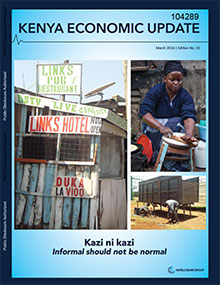 Kazi ni kazi - Informal Should Not Be Normal13TH KENYA ECONOMIC UPDATE, MARCH 2016
Kazi ni kazi - Informal Should Not Be Normal13TH KENYA ECONOMIC UPDATE, MARCH 2016This update comes in the wake of three game changing and mutually reinforcing trends. First, monetary policy in the United States (U.S.) will determine the direction of capital flows and currency stability. Second, the persistent decline in commodity prices will determine winners and losers and third, the cooling and rebalancing of the Chinese economy is likely to see a recalibration and change in the direction of trade. Kenya’s growth will depend on the net impact of these global trends on the one hand and the domestic policy response on the other. Growth in 2015 is estimated at 5.6 percent and is projected to rise to 5.9 percent in 2016 and 6 percent in 2017. The economy has created more jobs in the recent years, but these are low productivity mainly in the informal services sector and are not associated with higher value added. In the next ten years, nine million youth will enter the labor market, a majority will continue to find jobs in the informal sector. To improve productivity of these jobs, policy interventions can be geared towards increasing access to broad skills beyond formal education, creating linkages between formal and informal firms, and helping small scale firms enter local and global value chains. To encourage private sector growth and create better jobs, the business environment must improve. Finally, Kenya can leverage the changes in the global economy to recalibrate its trade as a platform for structural change and provide the impetus for higher levels of growth and creation of productive jobs.
-
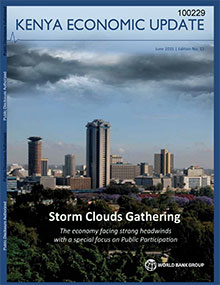 Storm Clouds Gathering – the economy facing strong headwinds with a special focus on public participation12TH KENYA ECONOMIC UPDATE, JUNE 2015
Storm Clouds Gathering – the economy facing strong headwinds with a special focus on public participation12TH KENYA ECONOMIC UPDATE, JUNE 2015Kenya’s economic performance remains solid, underpinned by strong infrastructure spending and consumer demand, which are driving growth. On the production side, growth from services, electricity generation, and a rebound in agriculture will drive growth in 2015. The World Bank estimates that growth will be 5.4 percent in 2015, a 0.6 percent downward revision of its estimate in December 2014. The revision reflects the strong headwinds the economy is facing in the foreign exchange market, the monetary policy response to calm those fears, and the fact that the effect of lower global oil prices on the wider economy was muted because of the depreciation of the shilling in 2015 and weak transmission into the wider economy. The revised figure is still higher than the average for both lower-middle-income countries and Sub-Saharan Africa. The risks to growth remain the same as in previous updates except for Chinese devaluation which has heightened global risks. The external sector remains vulnerable to further shocks from weak global export demand exacerbated by weak doing business environment, the continued strengthening of the United States (U.S.) dollar, and the authorities’ response to those external risks. Preliminary analysis shows that the direct transmission from events in China to Kenya are minimal as the renminbi closely tracks the U.S. dollar. While the fiscal deficit of 8.7 percent of gross domestic product (GDP) has raised concerns at the national level, it is the quality and transparency of spending that is paramount in the devolved system of government. Functional and political devolution to counties also seems beneficial for efficiency, as it provides incentives for county governments to deliver locally preferred services more efficiently, as the burden and benefits of public service delivery accrue in communities. Even though the benefits of devolution have not all been achieved and counties still going through a steep learning curve, a majority of Kenyans still support the devolved system of government despite the challenges being experienced in its implementation. Increasing public participation in budget information can help county governments become more efficient and targeted in the spending and reflect the voices of the people in their spending decisions.
-
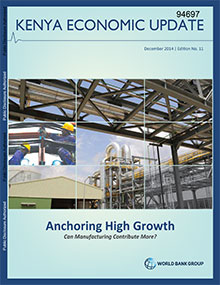 Anchoring High Growth - can manufacturing contribute more?11TH KENYA ECONOMIC UPDATE, DECEMBER 2014
Anchoring High Growth - can manufacturing contribute more?11TH KENYA ECONOMIC UPDATE, DECEMBER 2014This is the eleventh edition of the Kenya Economic Update. The special focus of this update examines the structural factors underpinning the poor performance of the manufacturing sector. Drawing on recent firm-level data from the 2010 Industrial Census and the 2013 Enterprise Survey. It investigates the extent to which the sector's lack of dynamism reflects problems in Kenya's business environment, which compares poorly to regional neighbors' on several manufacturing-relevant dimensions. The report has four main messages: First, Kenya begins 2015 in a sound economic position. After growing an estimated 5.4 percent in 2014, its economy is poised to be among the fastest growing in the region, with growth projected at 6.0 percent in 2015, 6.6 percent in 2016, and 7.0 percent in 2017. Second, the external sector remains weak and vulnerable, as import growth continue to outpace export growth and short-term flows finance the current account deficit. The large deficit points to underlying structural weaknesses in Kenya's economy, which need to be addressed. Third, Kenya needs to increase the competitiveness of the manufacturing sector so that it can grow, export, and create much-needed jobs. As a share of GDP, Kenya's manufacturing sector has been stagnant in recent years, and it has lost international market share; lastly, the weak business environment is a key constraint for the manufacturing sector. Obstacles to doing business affect this sector more than many others because manufacturing needs access to capital for investments, infrastructure to import inputs and export and distribute finished products, affordable and reliable electricity to produce, labor to man operations, and fair and streamlined regulations and trade policies that allow firms to compete.
-
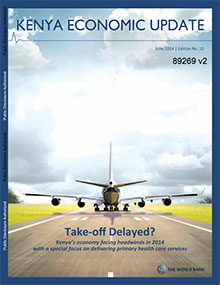 Take-off Delayed? Kenya’s economy facing headwinds in 2014 with a special focus on delivering primary health care services10TH KENYA ECONOMIC UPDATE, JUNE 2014
Take-off Delayed? Kenya’s economy facing headwinds in 2014 with a special focus on delivering primary health care services10TH KENYA ECONOMIC UPDATE, JUNE 2014Kenya's economy remains strong, enabling it to weather the headwinds it faces. Maintenance of macroeconomic stability and adherence to credible policies has underpinned Kenya's growth in the past. Continuing to adhere to these policies will help the country surmount domestic shocks, allowing it to grow 4.7 percent a year in 2014 and 2015. Addressing the pressures emerging from fiscal expansion is a priority. The large public sector wage bill and devolution have reduced fiscal buffers and increased fiscal risks. Kenya's health outcomes are not commensurate with its aspirations of achieving middle income status. Global evidence indicates that investing in primary health care is the most cost-effective way to improve health outcomes. Key recommendations to stabilize and sustain a robust growth include: (a) deepening fiscal consolidation without reducing infrastructure spending; and (b) expanding the engines of growth to include not only consumption but also investments and exports. Key recommendations that can help Kenya improve the delivery of primary health care include: (a) focusing first on making existing public primary health care facilities operational; (b) building on partnerships with faith-based organizations and partner with the private sector; and (c) the use of fixed facilities, such as inpatient services in many health centers that are grossly underutilized.
-
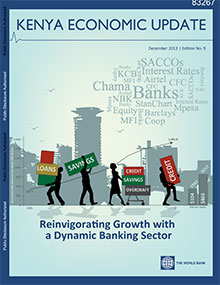 Reinvigorating Growth with a Dynamic Banking Sector9TH KENYA ECONOMIC UPDATE, DECEMBER 2013
Reinvigorating Growth with a Dynamic Banking Sector9TH KENYA ECONOMIC UPDATE, DECEMBER 2013Kenyans are living two decades longer; the fertility and infant mortality rates have been cut in half; and school enrollment, at both the primary and secondary level, has more than doubled. On the economic front, gross domestic product (GDP) per capita increased eightfold; the largest share of GDP is the services sector, not agriculture; and the financial sector is now the third largest in Sub-Saharan Africa (after South Africa and Nigeria). Kenya strengthened its external position substantially in recent years, accumulating international reserves to meet program targets under the successfully completed international monetary fund (IMF) program. Reforms have improved the resilience of the banking sector to domestic and international shocks. With the advent of mobile information and communications technology (ICT) developments, the ceiling for innovation targeting specific segments of the market and outreach has been raised almost indefinitely. Kenyan banks are ahead of their counterparts in Sub-Saharan Africa in terms of the share of lending to small and medium-size enterprises (SMEs) in their portfolios. A mature banking sector and more generally, a well-developed financial sector that supports a vibrant private sector will be an important advantage to achieving the vision 2030 goals.
-
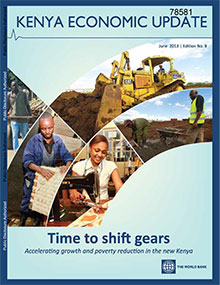 Time to Shift Gears: Accelerating Growth and Poverty Reduction in the New Kenya8TH KENYA ECONOMIC UPDATE, JUNE 2013
Time to Shift Gears: Accelerating Growth and Poverty Reduction in the New Kenya8TH KENYA ECONOMIC UPDATE, JUNE 2013The report has three main messages. First, the economy is expected to achieve higher growth targets in 2013 (5.7 percent) and 2014 (6 percent) over what it achieved in 2012 (4.6 percent), as a result of the smooth election process. However, the government will need to make a concerted effort, if it wishes to approach the 10 percent annual growth rate foreseen in Vision 2030. The report's second message emphasizes on the steps that the government needs to take to create an enabling framework for significant private sector-led growth. The Government needs to continue to invest in infrastructure, to increase domestic energy production, to address the other bottlenecks that affect the cost of doing business, and to continue following sound monetary and fiscal policies. Finally, the report's third message focuses on the poverty situation in Kenya, noting progress made since 2005, when an estimated 47 percent of the population lived below the poverty line, to the present, where poverty estimates range between 34 and 42 percent, the imprecision resulting from the lack of any recent survey data. The report notes the spatial dimension of poverty, and the poor tend to live in the arid and semi-arid regions in the north and north east. It concludes with thoughts about a poverty reduction strategy, which would emphasize on job creation, enhanced productivity of smallholder farms, strengthening and expanding cash transfer programs, targeted public spending programs to provide quality education to the rural poor, and improved poverty monitoring, so that the government can rapidly see which activities have the greatest impacts on improving the lives of the poor.
-
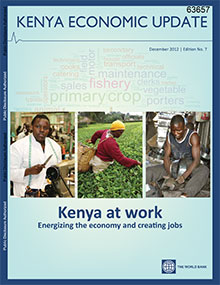 Kenya at Work, Energizing the Economy and Creating Jobs7TH KENYA ECONOMIC UPDATE, DECEMBER 2012
Kenya at Work, Energizing the Economy and Creating Jobs7TH KENYA ECONOMIC UPDATE, DECEMBER 2012Kenya withstood another difficult year in 2012 as policy tightening and weaker global demand slowed economic activity. With decisive fiscal and monetary policies, the government managed to restore confidence in Kenya's medium-term prospects. Kenya's growth rate is still below its potential and its peers, external imbalances remain which threaten its future growth, and the pace of economic growth is not generating enough modern sector wage jobs. With the passage of the new constitution in 2010 and its implementation, stronger institutions are emerging, putting Kenya on a sound footing ready to take off. In the very short term, what remains to be done is for Kenya to deliver a credible and peaceful election in March 2013, and thereafter a smooth transfer of power. In the medium term, Kenya will need to start building a stronger foundation for growth, and undertake structural reforms to correct the external imbalances. To generate more jobs for the burgeoning educated youth population, Kenya will also need to reduce the transaction cost for firms, by reducing job-smothering corruption and the cost of doing business (particularly in transport and energy).
-
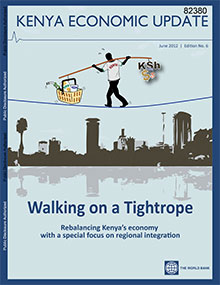 Walking on a Tightrope--Rebalancing Kenya's Economy with a Special Focus on Regional Integration6TH KENYA ECONOMIC UPDATE, June 2012
Walking on a Tightrope--Rebalancing Kenya's Economy with a Special Focus on Regional Integration6TH KENYA ECONOMIC UPDATE, June 2012In 2012, Kenya's economy has been on a tightrope. Policy makers have had to walk a fine line between stabilizing the economy and maintaining the growth momentum. While inflation has declined, the exchange rate stabilized, and the fiscal position improved, fundamental economic imbalances continue to make Kenya vulnerable to shocks. In the absence of economic and social turbulence, Kenya should grow at 5 percent in 2012 and 2013, which will still be substantially below its neighbors. Kenya has been benefitting from the integration and growth momentum in the East African Community (EAC), which has become one of the most vibrant economic regions in the world. However, despite impressive increases in trade between the five EAC partners in recent years, there is still a large untapped potential. EAC trade can increase several-fold if unnecessary restrictions in the trade of goods and services particularly nontariff barriers were removed.
-
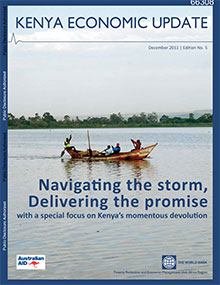 Navigating the Storm, Delivering the Promise with a Special Focus on Kenya's Momentous Devolution5TH KENYA ECONOMIC UPDATE, DECEMBER 2011
Navigating the Storm, Delivering the Promise with a Special Focus on Kenya's Momentous Devolution5TH KENYA ECONOMIC UPDATE, DECEMBER 2011Kenya is entering a decisive year. Three main developments will make 2012 extraordinary. First, Kenya will hold national elections for the first time since the traumatic post-election violence of 2007-08, which ended Kenya's high growth momentum abruptly. Second, Kenya's economy will need to navigate through a severe economic storm, which could well become a hurricane, especially if Europe enters into a recession. Third, the country will implement its most ambitious governance reforms ever, namely the devolution of responsibility to forty-seven new counties. Kenya's policy makers will need to display tremendous skill and steadfast leadership in order to balance the need for fiscal prudence, with ensuring that resource flows to new local governments are sufficient to meet their needs. High expectations of the promise of devolution need to be met by equally high-quality planning and execution of its delivery. Kenya will enter 2012 from a weaker-than expected economic position. Kenya's economy is navigating rough economic waters, where existing structural weaknesses have been compounded by short-term shocks. The most visible sign of Kenya's economic challenge is the depreciating shilling, which reached an all-time low against the US Dollar in October 2011. The elements behind this situation are high international food and fuel prices, the drought compounded by conflict in the horn of Africa, the Euro crisis, widening fiscal and current account deficits, and major inefficiencies in Kenya's agriculture sector. The recent developments are also undermining one of Kenya's main strengths over the last decade: the credibility and predictability of its macroeconomic policies.
-
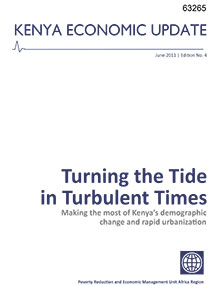 Turning the Tide in Turbulent Times Making the most of Kenya’s demographic change and rapid urbanization Turning the Tide in Turbulent Times4TH KENYA ECONOMIC UPDATE, JUNE 2011
Turning the Tide in Turbulent Times Making the most of Kenya’s demographic change and rapid urbanization Turning the Tide in Turbulent Times4TH KENYA ECONOMIC UPDATE, JUNE 2011Over the last decade, Kenya's society and economy have changed fundamentally, and these deep trends will continue. Rapid population growth and urbanization will create many new challenges which need to be managed well to support Kenya's economic take-off in the medium-term. This fourth edition of the Kenya economic update argues that Kenya can turn the tide in turbulent times and make the most of the ongoing structural shifts. In 2011, Kenya will need to address short-term domestic and international shocks, including higher inflation, pressures on the exchange rate and, most importantly, a volatile political environment. The government will need to navigate through these shocks successfully and to continue with its economic reform program to achieve higher growth. At the same time, the government will be making major strategic decisions in Kenya's decentralization architecture which will shape the medium-term development prospects of the country. Economic success is possible, as the 5.6 percent growth in 2010 has shown. If growth will accelerate to an average of 6 percent this decade, Kenya will achieve middle income country status by 2019.
-
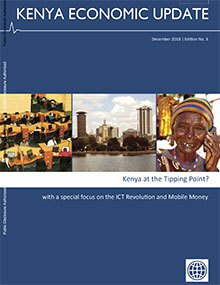 Kenya at the Tipping Point? with a special focus on the ICT Revolution and Mobile Money3RD KENYA ECONOMIC UPDATE, DECEMBER 2010
Kenya at the Tipping Point? with a special focus on the ICT Revolution and Mobile Money3RD KENYA ECONOMIC UPDATE, DECEMBER 2010Kenya may be at a "tipping point," the theme of the third Kenya economic update which has a special focus on the transformative impact of information and communication technology (ICT) and mobile money. Over the last decade, ICT has outperformed all others sectors growing at an average of 20 percent per year. The benefits of ICT are starting to be felt in other sectors and have contributed to the conditions for Kenya to reach this tipping point. Kenya has entered the new decade with renewed and stronger than expected growth. The passing of the new constitution continued strong macroeconomic policies, and a favorable regional environment have created a new positive economic momentum. Kenya may again be positioned to experience high growth. Over the last three decades Kenya has experienced only two short episodes when economic growth exceeded five percent and was sustained for at least three consecutive years: 1986-88, and 2004-2007. Is Kenya again at the verge of experiencing another growth spurt? Will it last longer and go deeper than the previous two episodes?
-
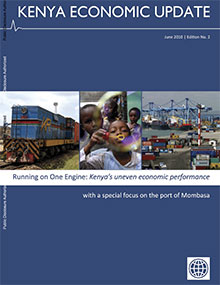 Running on one Engine: Kenya’s uneven economic performance with a special focus on the Port of Mombasa2ND KENYA ECONOMIC UPDATE, JUNE 2010
Running on one Engine: Kenya’s uneven economic performance with a special focus on the Port of Mombasa2ND KENYA ECONOMIC UPDATE, JUNE 2010Kenya has entered a new decade with renewed momentum for strong and sustained growth. Being part of Africa's strong recovery after the global crisis and a regional leader in services, Kenya has high hopes for a strong economic performance during this new decade. After two years low growth, the World Bank projects 4.0 percent growth in 2010 which means that most Kenyans will again experience an improvement in their living conditions. To achieve and sustain high growth over the next decade, Kenya will need to address its economic imbalances, avoid domestic shocks, and manage the impacts of future external crises. The theme of this second Kenya economic update, "running on one engine", reflects the structural imbalance of Kenya's current economy-Kenya's strong engine is domestic consumption; its weak engine is exports. In order to restart the export engine, Kenya will need to address a number of issues, especially the infrastructure deficit. The port of Mombasa for example, is Kenya's most important and concentrated infrastructure asset. As the special focus section of this report concludes, the port needs substantial reform and upgrading to reach international standards and to meet the demands of a growing and increasingly integrated East African Community.
-
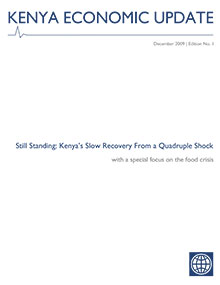 Still Standing : Kenya's Slow Recovery From a Quadruple Shock with a special focus on the food crisis1ST KENYA ECONOMIC UPDATE, DECEMBER 2009
Still Standing : Kenya's Slow Recovery From a Quadruple Shock with a special focus on the food crisis1ST KENYA ECONOMIC UPDATE, DECEMBER 2009This is the first edition of the Kenya Economic Update. This title of this report has two meanings, which are both true for Kenya today. First, the economy seems to stand still as economic growth barely matches population growth, indicating that Kenya continues to operate below its potential. Second, Kenya's economy has weathered four consecutive crises - post-election violence, global food crisis, global financial turmoil, and drought - well enough so that its economy is "still standing". This report looks at both of these dimensions and analyzes the weaknesses (and partial strengths) of the current growth momentum as well as Kenya's resilience, particularly with respect to the global financial crisis. This first issue of the Kenya Economic Update examines the ways in which the Kenyan economy has been affected by four waves of crises. Section one describes the growth outlook for 2009, and how the phenomenon of slow recovery manifested itself across the different sectors of activity. Section two drills deeper into the successive waves of crisis, the transmission mechanisms through which they affected the economy, as well as the government’s response to date. Finally, section three concludes the economic update with scenarios for growth in 2010 and an analysis of the assumptions behind them.
